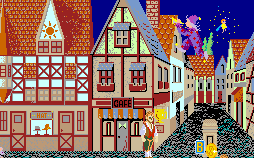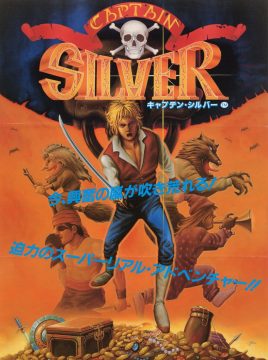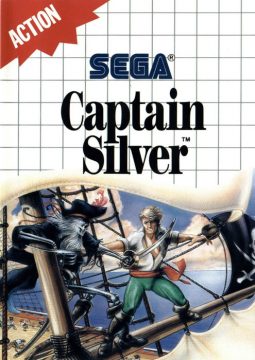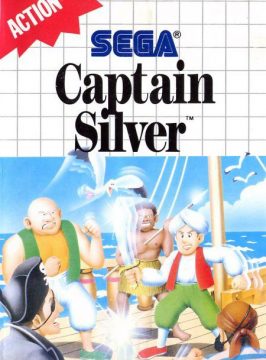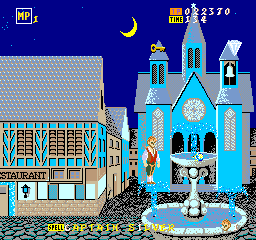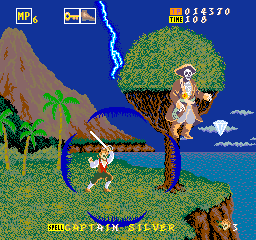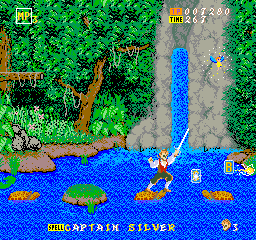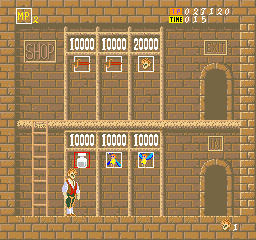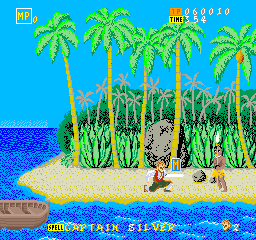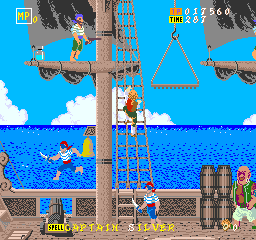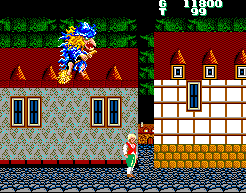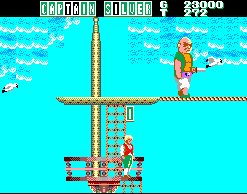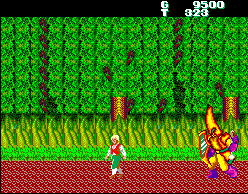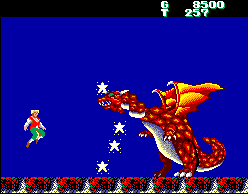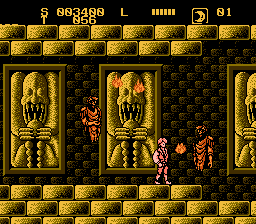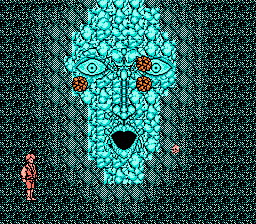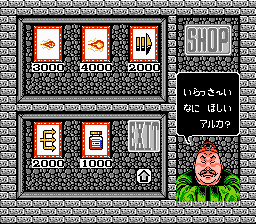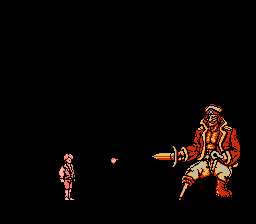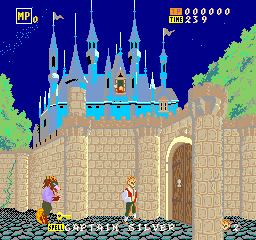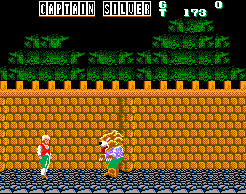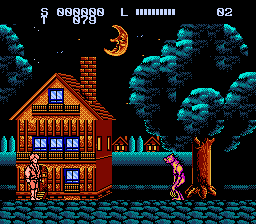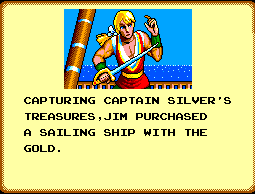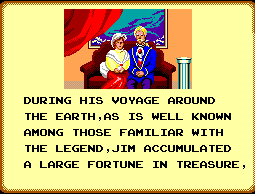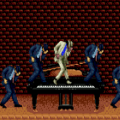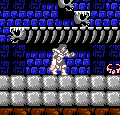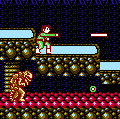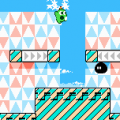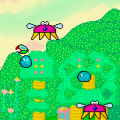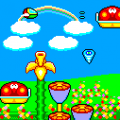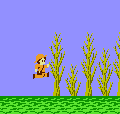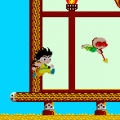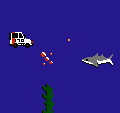In Data East’s Captain Silver, you play as an adventurous lad named Jim, who seeks treasure, glory, and riches. A fair enough aspiration, with one tragic flaw – Jim is an awful pirate. Early in the game, if he steps in a water fountain that’s approximately a foot deep, he’ll immediately drown. Not exactly the sort of person that’s cut out for a life on the high seas.
During his adventures, he attracts the unwanted attention of wolves, pumpkins, witches, other pirates, several kinds of fish, crabs, birds, more pirates, man-eating plants, angry natives, the Pied Piper of Hamelin, coconuts, the Cheshire Cat, and pirate ghosts. These bad guys absolutely flood the playing field – some are triggered by your movement through each stage, but many spawn randomly from both sides of the screen, leading for all kinds of hilarious no-win opportunities where enemies attack from both sides. The life of a video game protagonist is usually a harsh one, but Jim can only take a single hit before perishing, which sends him back to a checkpoint earlier in the stage. Said checkpoint is usually at the beginning of the stage, or somewhere in the middle.
If this sounds a lot like Capcom’s Ghosts ‘n Goblins – well, it is. The pacing is very similar, as is the brutally unforgiving difficulty level. However, at least Arthur could take two hits. Arthur also had a wide variety of projectile weapons. Jim’s only weapon is a sword, which, thankfully, he’s actually quite adept with. He swings quickly, and he swipes at an arc. This means it can hit enemies behind and above Jim, which is extremely handy for all of the bad guys that pop right out of the sky. What isn’t so handy is the shoddy hit detection – whenever you get hit, the action freezes and a small marker exposes the area that was damaged. It’s awesome when this marker is several pixels from Jim – why would the programmers intentionally highlight how awful their coding is?
There are a couple of bonus items that try to make life easier. You can find boots that allow you to jump higher, although it’s barely useful. You can find potions that will all you to absorb a single hit, which is incredibly useful, if short lived. You can also find floating fairies, which will charge your sword with the ability to shoot projectiles. If you collect multiple fairies, it’ll eventually get upgraded into a multi-directional shot, then finally a huge series of waves that shoot out in three directions. It’s a shame that this wasn’t easier to obtain – it’s doubtful that most gamers will ever bother to get beyond the first level, much less stay alive long enough to grab enough fairies.
Captain Silver also tries – and spectacularly fails – to implement some vague adventure elements. Your “score” also acts as a form of currency, which can be to purchase items at shops. There are also a few instances where you’ll find a locked door, but the key is usually right next to it, which kind of defeats the point. Most of the enemies drop letters too. If you spell out the game’s title – CAPTAIN SILVER – you’ll glow for a second and get an extra life. It’s a nice gesture, but with a game this difficult, it would’ve been nice if you got some cool magic or something.
There are only four stages, but the final area is quite long. Most of the levels are flat – this is actually a good thing, because the few platforming segments are absolutely dreadful. Jim visibly shakes whenever he’s on a moving platform, in which case he might decide to fall right through it to his death. This section is also right before the final boss, so if he kills you, you get to experience this same segment again. The entire third level (and part of the first) consists of nothing but Jim and a raft, as you sail through the seas, attempting to survive a seemingly non-stop onslaught of fish and sea gulls.
It’s cool to see a pirate-themed game, a genre that’s usually overlooked by developers in favor of generic fantasy and sci-fi, but otherwise, the only notable thing about Captain Silver is its difficulty. Furthermore, you actually need to beat the whole game twice to see the real ending, another holdover from Ghosts n’ Goblins. This game revels is making the gamer feel pain.
At any rate, most Western gamers are probably familiar with the Sega Master System version, since the arcade version barely got any distribution outside of Japan, if at all. It’s admirable that they tried their darnedest to make it better.
The system limitations actually work in its favor. The enemies aren’t nearly as fast, nor as numerous – this alone makes the difficulty much more manageable. The graphics have technically been downgraded, but they look much better. The arcade version seemed to have been designed by a blind person who suddenly regained their sight and splashed the screen with every color they could, with a complete disregard for how it actually looked. When working with a fraction of the color palette, it’s much more cohesive, even if it’s still pretty average compared to other Sega Master System games. The final stage has been cut into two separate levels, and the level on the pirate ship has been expanded.
The American version is drastically cut down from the Japanese and European versions. The American version only has four levels, while the European one has six. The American one is missing the stage where Jim is floating out on sea with a raft – admittedly, an obnoxious stage – as well as a level that takes place in a cave, which wasn’t in the arcade version either. There’s also a whole segment of the final stage which was cut. It’s not just the levels – several bad guys were removed, including a number of bosses. Most of these were exclusive to this home port, such as a rock throwing Cyclops and a huge dragon. The European version also features an ending with still pictures, while the American version consists of a mere text scroll.
Overall, this is kind of a mixed bag – the American version is pretty easy since it’s missing half the cast of bad guys, which makes it kind of boring. The European version is much more interesting, but the boss battles – especially a fight against an incredibly obnoxious knight dressed like a banana – are quite frustrating. Still, the American version is just way too short and lacking in substance, and it’s hard to recommend a release that’s been butchered so heavily. And the reason for all this content removal? Undoubtedly it was due to cost cutting measures – the American version is one megabit, while the European version is two. Strangely, the American manual references the stages and enemies that were removed from its release. You can tell the different releases by their cover art – the European version is more cartoony than the American one, which has a more realistic art style.
The Sega Master System version isn’t spectacular, but it’s still one of the better games for the system’s library by default. The same can’t be said of the Famicom version, published by Tokuma Shoten. The developers realized that the single hit kills were pretty stupid, so they gave you a life bar. This technically makes the game easier, but most of the enemies now take several hits, and their movement patterns are hard to dodge. Like the arcade version, it also takes extraordinary liberties with the concept of “hit detection”, so it’s kind of a crap shoot as to whether you take damage or not. Jim is terribly animated and he can no longer swings his sword at an arc, which looks pretty stupid. The backgrounds look okay, but in general, the sprites are really awful.
The Sega Master System version featured pretty faithful levels that were expanded in a few areas, while the Famicom version adds more original aspects. The first two stages are roughly the same, but includes an extended area underneath the pirate ship, much like the SMS game. But the raft stage has been shortened and includes a section in an ocean cave, and the jungle level now features some ancient ruins.
Again, like the SMS game, there are boss battles, but here they’re completely different. The screen goes dark and you fight gigantic renditions of Frankenstein’s Monster, some pirate dude, a squid, a flying statue, a giant face (??) and finally the ghost of Captain Silver. There are a few doors where you’re treated to some “advice” by a witch, and the store now features a slightly racist Chinese shopkeeper.
There are many more magic spells to be bought, which can be equipped on the pause screen. Also, there’s no more collecting letters, so you can only get extra lives through purchasing them at the shop. These enhancements are nice, but the core game is so poorly implemented and dull that it all goes to waste.
Links:
Gamefreaks365 – Captain Silver Review of the European and American SMS games.
Something Awful ROM Pit – Captain Silver Scathing review of the Famicom game.
Digital Press Online – Captain Silver Details the differences between the SMS versions.
Screenshot Comparisons
